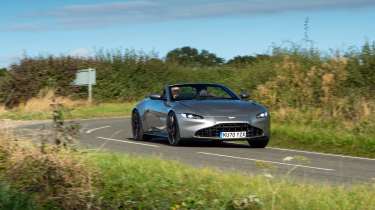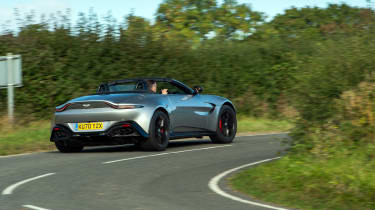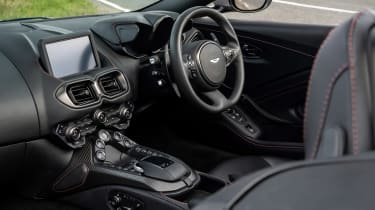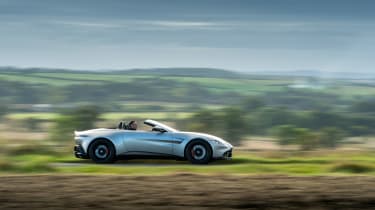Aston Martin Vantage Roadster (2021 - 2023) review
Aston Martin’s Vantage Roadster is just as rewarding to drive as the Coupe, but comes with an extra level of drama and excitement
Even when quietly dozing in a gravel car park in Bedfordshire, the Aston Martin Vantage Roadster instantly takes you to a brighter place. The weather is mild and sunny, but not quite what you might have in mind when considering romantic notions of an open-top Aston.
The original Vantage Roadster press launch was scheduled for just such a place, Palm Springs specifically, but that was until Covid arrived. I sure can imagine it there though, and it’s hard to think of anything more suitable for a cruise around that region of California, basking in the endless sunshine and looking out across Joshua Tree National Park at the Big Country.
Yet even in less glamorous locations, the Roadster looks good, really properly tasty in the metal, and without wishing to state the obvious, with a car in this market niche, that’s of vital importance. Yes, I know it’s all subjective, but somehow the neatly integrated fabric roof has really simplified and enhanced the Vantage’s design to my eyes, decluttering it and accentuating the good bits. It’s almost as if it was born to be a roadster and had the roof designed in at a later date, although as Aston’s chief engineer, Matt Becker, tells us, both open and closed cars were developed at the same time. This also explains why the Roadster is only 60kg heavier than an equivalently specced Vantage coupe and why Becker claims it possesses outstanding levels of rigidity for a drop-top; it was designed to be one from the start.
Entering into the spirit of the moment, I drop the roof before we get under way. It takes less than seven seconds, which according to Aston Martin is the quickest fully automatic folding roof on the market. Good on ’em, I say, because it is a very slick operation with just one press of the button required – although clearly still a lot slower than the manual roof in a tatty old Mk1 MX-5 that smells of damp carpet and has an opaque rear window.
More reviews
Much of the Vantage Roadster is as you would expect. There’s the excellent AMG-sourced twin-turbo 4-litre V8, producing a healthy 503bhp and 505lb ft of torque, hooked up to the eight-speed automatic transmission. It enables the Roadster to have a 0-62mph time of 3.8sec and a top speed of 190mph – only two-tenths and 5mph down on the coupe. Entirely respectable in the circumstances, I’m sure you’ll agree. The firm has also revised the chassis settings, both in the name of continuous improvement and to compensate not only for the mild increase in weight but also the small change in the weight distribution with the fitment of the electric roof. Spring and damper rates are revised, and the rear anti-roll bar is slightly thicker.
> Aston Martin Vantage full review
The first impressions of the Roadster are ones that never leave. It feels big, imposing, easy to drive and sky-high on the feel-good scale. The V8 channels the vibes of a tugboat at idle, particularly if you’ve switched the powertrain up from Sport to Sport+, or Track, and makes all the right rumbling noises on the move, the note morphing into a sweeter howl than in a purely AMG installation. Crackles and pops are only a lift of the throttle away, if that’s your thing. As with the coupe, the Vantage calibration means the engine has a definite power curve that climbs rather than swamping you with an instant and overwhelming wodge of torque at low revs, which makes using what it has to give all the more enjoyable.
Perhaps that’s just as well, because this is a car that always feels like a break in the tractive properties of the rear tyres is only a flex of the toes away, and as we know from prior experience, in inclement conditions you have to work hard (and be very sensitive) not to constantly trigger the traction control system or – with it disabled – have a very busy time at the wheel combating oversteer. It could be said though that such behaviour is part of the Vantage’s charm, because it’s a car that offers a very different experience to that of an open-roofed Porsche 911, whether Cabriolet or Targa, which has a much more straight-laced character.
Part of that is down to the physical size and weight of the car. Aston Martin quotes a dry weight of 1628kg, but then adds that this is the lightest possible figure with ‘lightweight options’. Given you can expect to add around 100kg in fluids to that to arrive at a DIN figure (the type we usually quote in evo) it’s clear that a standard Roadster is going to be a bit too much on the portly side to be classed as a sports car in the traditional sense; we’d love to put one on our scales and see exactly what it comes out at. It’s wide too – the same as the coupe, obviously – at nearly 2 metres before mirrors are taken into account. So while its quick steering and keenly judged chassis dynamics make it feel alert and agile, the more you push on, the more you’re aware of significant mass on the move.
Psychologically, the width of the car, combined with extremities that slope away out of sight, does impact upon your commitment when driving the Roadster on B-roads, the high scuttle and limited view out making it more of a challenge to judge narrow gaps at speed. It can also make 500bhp-plus feel not quite as bombastic as the figures might suggest, just in those initial milliseconds when summoning the throttle, although it’s more than quick enough once it’s got into its stride and full-bore acceleration can have the rear axle shuffling slightly from side to side as it copes with transmitting the V8’s torque onto the road’s surface.
A conventional automatic gearbox, however well calibrated, isn’t the stuff of sports car dreams either (the seven-speed manual ’box isn’t available in the Roadster), and while the paddles are there if you want the driver interaction, I find my commitment to them tested by gearchanges that aren’t positive in the way those of a twin-clutch ’box can be, and the constant need to decide which of the eight cogs is the correct one for any given moment. It’s all too easy to just tune out a bit and let the Roadster sort it out for itself. It can do it perfectly well, but personally I’d rather be making those decisions.
True to the claims, the integrity of the shell is not in question, with very little flex felt through either the wheel or the driver’s backside to betray the structure has been compromised in any way, and no real rear-view mirror shake to speak of. There’s some buffeting in the cabin at speed, but nothing that’s too noticeable, and the air is warm enough today to make it entirely pleasant. The verdant surroundings also take the mind off an interior that fails to match the car’s outside for clarity of design. Aston has since proved it can do much better, with the DBX for example, so an update in here wouldn’t go amiss, and the sooner the better at this price point. The steering wheel-mounted buttons for the chassis and powertrain modes continue to frustrate too, as a light touch sometimes doesn’t register, and the modes also have to be cycled through to get back to the beginning again. Annoying if you’re in Sport+ and just want to go back to Sport.
Where the Vantage Roadster really scores is when howling along a country road, taking curves with precision, offering an uninterrupted view of the surrounding countryside while the world looking on gets to see and hear a beautiful car in full flight. If we weight our verdict to emphasise those points then I think the Vantage Roadster does superbly, for it also does more than enough in other areas where it is weaker; in fact, I think I would prefer it over a high-spec 992 Cabriolet for these very reasons. In being thus it builds upon the inherent abilities and charms of the coupe to become one of modern-era Aston Martin’s best judged products yet, whatever side of the world you’re driving on.
Specifications
| Engine | V8, 3982cc, twin-turbo |
| Power | 503bhp @ 6000rpm |
| Torque | 505lb ft @ 2000-5000rpm |
| Weight (dry) | 1628kg (314bhp/ton) |
| 0-62mph | 3.8sec |
| Top speed | 190mph |






